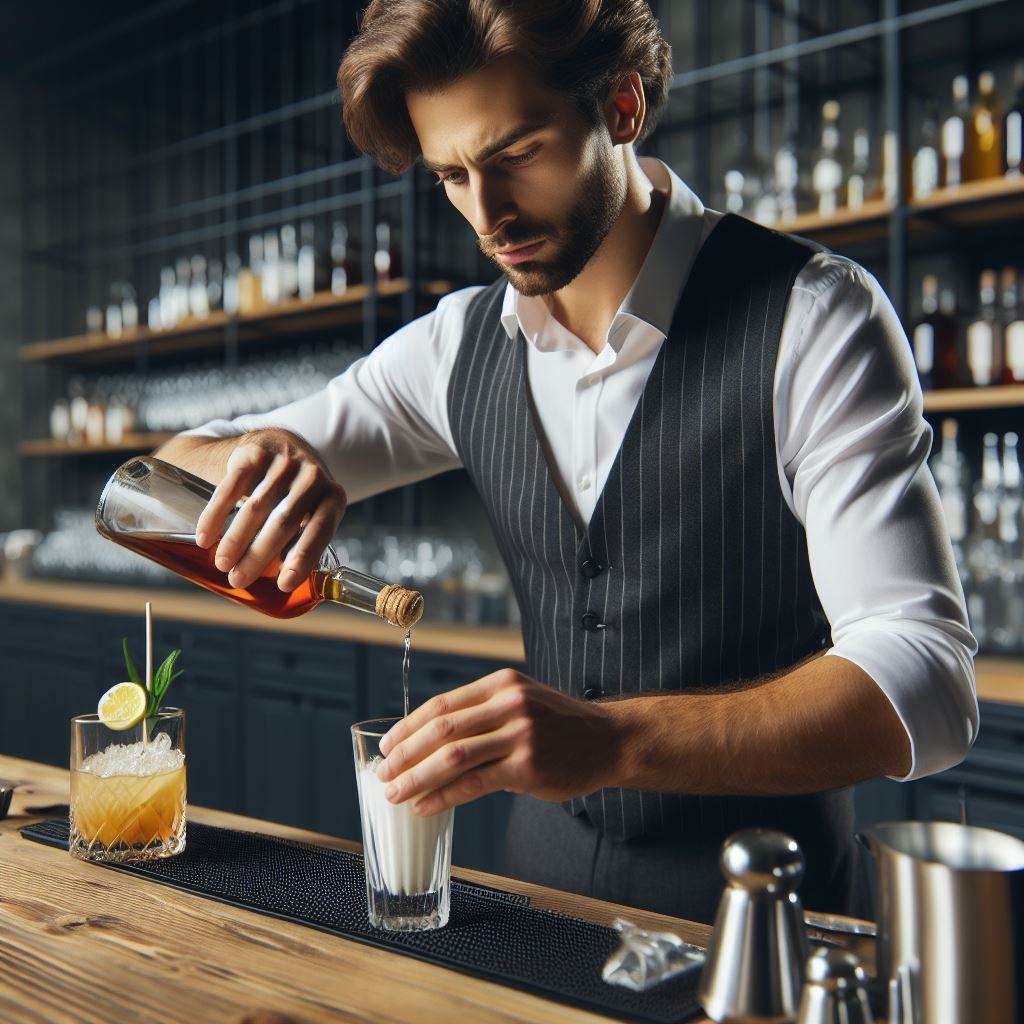Introduction
In New Zealand, the health and safety of bartenders is a crucial topic that demands attention and prioritization.
It is essential to recognize and address the importance of maintaining a safe and healthy work environment for these professionals.
Bartending requires physical stamina and often involves handling potentially hazardous substances, such as alcohol and cleaning chemicals.
Thus, understanding and implementing health and safety measures is vital to mitigate the risks associated with this profession.
The hospitality industry, including bars and nightclubs, can be fast-paced and high-pressure environments.
Bartenders are constantly exposed to various safety hazards, such as slips and falls, cuts from glassware, and even confrontations with unruly patrons.
Therefore, it is crucial to develop effective strategies to prevent accidents and promote well-being.
Promoting health and safety not only benefits the bartenders themselves but also ensures a positive experience for customers.
Engaging in proactive measures to safeguard employee well-being contributes to the overall success and reputation of the establishment.
In this blog post, we will explore the specific health and safety considerations that bartenders in New Zealand should be aware of.
We will discuss topics such as proper handling and storage of hazardous substances, steps to create a safe working environment, and the significance of emergency response training.
By following these guidelines and adopting a proactive approach, bartenders can effectively minimize risks, protect their health, and ensure a safe and enjoyable experience for both themselves and their customers.
Let’s dive into the essential aspects of health and safety for bartenders in New Zealand!
Understanding the Occupational Health and Safety Act
In New Zealand, the Occupational Health and Safety Act (OHSA) plays a crucial role in ensuring the health and safety of workers, including those in the bartending industry.
Overview of the Occupational Health and Safety Act
The OHSA is a legislation that aims to prevent work-related injuries, illnesses, and fatalities.
Personalized Career Consulting
Unlock your potential with expert career advice tailored to your goals. Get personalized guidance and actionable steps toward your dream career in New Zealand.
Get StartedIt provides a comprehensive framework for managing workplace hazards and promoting a safe working environment.
The Act applies to all workplaces and covers a wide range of industries, including bartending.
Its objective is to reduce harm caused by work activities and foster a culture of safety.
Relevance to the Bartending Industry
Bartending may seem like a low-risk profession, but it still poses several potential hazards.
The OHSA ensures that bartenders are protected from these hazards and promotes their overall well-being.
It addresses risks such as slips, trips, and falls, ergonomic issues, and exposure to hazardous substances.
By complying with the Act, employers can create a safe and healthy workplace for bartenders.
Responsibilities of Bartenders and Employers
Bartenders have a responsibility to ensure their own health and safety, as well as that of their customers.
They should follow safe work practices, be aware of potential hazards, and report any concerns to their employers.
Employers, on the other hand, have a legal obligation to provide a safe workplace.
They must identify hazards, assess risks, and implement control measures to eliminate or minimize those risks.
Employers should also provide training and information to bartenders regarding health and safety in their workplace.
Regular inspections and maintenance of equipment should be conducted to ensure safety.
Both bartenders and employers should collaborate to create a culture of safety and prioritize the well-being of all.
Transform Your Career with a Professional CV and Cover Letter
Stand out to employers with an ATS-optimized resume and tailored cover letter designed to match your dream role. Let us craft your job application materials for success!
Get StartedBy understanding the Occupational Health and Safety Act, bartenders and employers can work together to uphold the highest standards of health and safety in the industry.
Compliance with the Act not only protects bartenders and their customers from harm, but also contributes to the overall success and reputation of the establishment.
It is essential for bartenders to familiarize themselves with the Act and actively participate in promoting a safe working environment.
Similarly, employers must take their responsibilities seriously and prioritize the health and safety of their bartending staff.
Ultimately, by adhering to the Occupational Health and Safety Act, the bartending industry in New Zealand can thrive while ensuring the well-being and protection of its workers.
Read: Bartending Competitions Across NZ
Common Hazards in Bartending
Being a bartender can be a fun and rewarding job, but it also comes with its fair share of hazards.
In this section, we will be discussing the most common hazards faced by bartenders in their workplace and how to mitigate them.
Physical Hazards
- Slips and Falls: Bartenders are constantly on their feet and working in a fast-paced environment, which can lead to slippery floors and potential falls.
It is crucial to maintain clean and dry floors and wear slip-resistant shoes. - Burns: Bartenders often deal with hot liquids, such as boiling water and steam from coffee machines.
Proper training and wearing protective gloves can help prevent burns. - Lifting Heavy Objects: Moving kegs, crates, and other heavy items is a regular part of a bartender’s job.
Using proper lifting techniques and asking for assistance when needed can prevent back strains and injuries.
Chemical Hazards
- Handling Cleaning Agents: Bartenders frequently clean bar equipment using chemicals that can be hazardous if not handled correctly.
It is essential to wear gloves and protective eyewear while handling cleaning agents. - Alcoholic Beverages: Bartenders regularly come into contact with alcoholic beverages, which can lead to overexposure if proper precautions are not taken.
They must be aware of the effects of alcohol and practice responsible consumption.
Ergonomic Hazards
- Repetitive Motions: Bartenders often perform repetitive tasks, such as pouring drinks and mixing ingredients, which can strain muscles and lead to musculoskeletal disorders.
Taking regular breaks and practicing stretching exercises can help prevent these issues. - Poor Posture: Standing for long periods without proper posture can cause back and joint pain.
Bartenders should be conscious of their posture, use ergonomic mats, and consider adjustable workstations to maintain good posture.
By being aware of these common hazards and taking necessary precautions, bartenders can ensure their health and safety in the workplace.
Employers should also provide proper training, enforce safety measures, and provide necessary protective equipment to create a safe working environment.
Remember, a healthy and safe bartender is a happy bartender, ready to serve customers with a smile!
Read: Cocktail Recipes from Top NZ Bartenders
Preventing Workplace Injuries
As bartenders, it is crucial to prioritize your health and safety while working.
By following these tips, you can prevent injuries and accidents at your workplace:
Boost Your Career with a Standout LinkedIn Profile
Attract recruiters and expand your network with a fully optimized LinkedIn profile tailored to highlight your strengths and professional goals. Let your profile open doors to new opportunities!
Get Optimized1. Proper Lifting Techniques and Use of Assistive Devices
- Always bend your knees and use your leg muscles when lifting heavy items.
- Avoid twisting your body while lifting to prevent strains and sprains.
- Use equipment such as trolleys or lifting belts to assist with heavy loads.
2. Maintaining Cleanliness and Order in the Workplace
- Regularly clean spills and hazards immediately to prevent slip and fall incidents.
- Keep walkways clear of clutter and obstacles to avoid accidents.
- Properly store tools and equipment to minimize the risk of accidents or injuries.
3. Using Personal Protective Equipment
- Wear non-slip shoes to prevent slips and falls, especially in wet areas.
- Use gloves when handling sharp objects or harmful chemicals.
- Protect your hearing by wearing earplugs in loud environments.
4. Taking Regular Breaks to Prevent Fatigue and Musculoskeletal Disorders
- Avoid working long hours without breaks, as it can lead to exhaustion and decreased focus.
- Stretch and exercise during breaks to relieve muscle tension and improve circulation.
- Listen to your body and rest when you feel fatigued or experience discomfort.
By implementing these measures, bartenders can create a safe and healthy working environment, minimizing the risk of workplace injuries.
Remember, your well-being is essential, so prioritize safety every day. Cheers to your health!
Read: Bartending: Part-Time Career in NZ

Mental and Emotional Well-being
Being a bartender can be mentally and emotionally challenging.
Bartenders face various difficulties that can impact their mental and emotional health.
Mental and emotional health challenges faced by bartenders
Bartenders often have to deal with demanding customers, manage multiple tasks, and work long hours in a high-pressure environment.
Bartenders work late nights and weekends, which can disrupt their sleep patterns and social life.
This lifestyle can lead to stress and burnout.
Bartenders are constantly in contact with alcohol and witness its effects on people.
They may encounter challenging situations related to excessive drinking, aggression, or substance abuse.
Coping mechanisms and strategies to support mental and emotional well-being
It is crucial for bartenders to develop effective coping mechanisms to maintain their mental and emotional well-being.
Engaging in regular exercise, meditation, or other stress-reducing activities can help manage job-related stress.
Creating a support network with colleagues and friends can provide a platform to share experiences and seek advice.
Setting boundaries and taking breaks during shifts can prevent feeling overwhelmed and reduce mental fatigue.
Importance of seeking support and destigmatizing mental health issues in the industry
Bartenders should not hesitate to seek professional help or counseling if they are struggling with their mental or emotional health.
It is essential to break the taboo surrounding mental health in the hospitality industry.
Encouraging open conversations about mental health can create a supportive environment where bartenders feel comfortable seeking help.
Training programs for bartenders should include education on recognizing and addressing mental health issues.
Support from employers and colleagues
Bartenders should feel supported by their employers and colleagues in terms of mental and emotional well-being.
Employers can provide resources such as access to counseling services or mental health workshops.
Colleagues can support each other by listening, offering assistance, and encouraging self-care.
Work-life balance
Establishing a healthy work-life balance is crucial for bartenders’ mental and emotional well-being.
Implementing fair work schedules that allow for adequate rest and time off can prevent burnout.
Encouraging bartenders to pursue hobbies and engage in activities outside of work can promote overall well-being.
Creating a positive workplace culture
Fostering a positive and supportive workplace culture can contribute to bartenders’ mental and emotional well-being.
Recognizing and appreciating bartenders’ efforts can boost morale and job satisfaction.
Promoting team-building activities and fostering a sense of camaraderie among staff members can create a supportive work environment.
Overall, understanding and addressing the mental and emotional health challenges that bartenders face is crucial for their well-being and the overall success of the industry.
By providing support, resources, and promoting a positive workplace culture, bartenders can thrive both professionally and personally.
Read: Mixology Trends in New Zealand 2024
Alcohol Awareness and Responsible Service
Role of bartenders in promoting responsible drinking and preventing alcohol-related harm
In the world of bartending, promoting responsible drinking and preventing alcohol-related harm is of utmost importance.
Bartenders play a crucial role in ensuring that their customers consume beverages safely and in moderation.
Legal obligations of bartenders regarding serving alcohol to intoxicated individuals
It is essential for bartenders to be aware of their legal obligations regarding serving alcohol to intoxicated individuals.
By law, serving alcohol to someone who is visibly intoxicated is strictly prohibited and can have severe consequences.
Recognizing the signs of intoxication is an essential skill that all bartenders must possess.
Training resources and tips for recognizing signs of intoxication
Training resources can be incredibly helpful in learning how to identify these signs.
- Attend workshops or seminars on responsible alcohol service provided by industry organizations.
- Become certified in alcohol awareness and keep up to date with training programs.
- Participate in online courses or webinars that focus on recognizing the signs of intoxication.
- Learn from experienced bartenders who can provide valuable insights and tips.
However, recognizing signs of intoxication is only the first step.
Strategies for addressing potentially challenging situations involving intoxicated or underage customers
Bartenders must also be prepared to handle potentially challenging situations that involve intoxicated or underage customers.
- Maintain a calm and composed demeanor to diffuse any confrontational situations.
- Politely and discreetly approach intoxicated individuals to assess their level of impairment.
- Refuse service to anyone who is visibly intoxicated, citing legal obligations and concern for their well-being.
- Suggest non-alcoholic alternatives or water to intoxicated customers.
- Seek assistance from a manager or security personnel if the situation escalates or becomes concerning.
Bartenders should never hesitate to ask for help if they find themselves in a challenging or potentially dangerous situation.
Remember, the well-being and safety of customers always come first.
Additionally, bartenders can contribute to alcohol awareness by actively promoting responsible drinking among customers.
Ways Bartenders Can Promote Responsible Drinking
- Encourage customers to pace themselves and drink water in between alcoholic beverages.
- Serve smaller portions of alcohol to promote moderation.
- Display visible signs with information on alcohol units and safe drinking guidelines.
- Offer a range of low-alcohol or non-alcoholic options for customers to choose from.
- Engage in open conversations about responsible drinking and provide knowledgeable advice.
Bartenders hold a significant and influential position when it comes to alcohol consumption.
By fulfilling their legal obligations, being well-trained in recognizing signs of intoxication, and promoting responsible drinking, bartenders can contribute to a safer drinking culture in New Zealand.
Ultimately, it is in the best interest of both the bartending community and the customers they serve.
Conclusion
Prioritizing health and safety for bartenders in New Zealand is crucial.
Bartenders should take proactive measures to prevent workplace injuries and promote their well-being.
It is important for them to educate themselves about health and safety regulations and practices.
Resources are available to support bartenders in furthering their knowledge in this area.
By staying informed and taking necessary precautions, bartenders can ensure a safe and healthy work environment.




